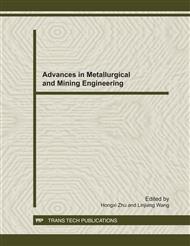[1]
Clarkson, Christopher R., and Marc Bustin. 2011. Coalbed Methane: Current Field-Based Evaluation Methods. SPE Reservoir Evaluation & Engineering 14 (1).
DOI: 10.2118/131791-pa
Google Scholar
[2]
El-Banbi, Ahmed H., and Robert A. Wattenbarger. 1996. Analysis of Commingled Tight Gas Reservoirs. In SPE Annual Technical Conference and Exhibition. Denver, Colorado: 1996 Copyright 1996, Society of Petroleum Engineers, Inc.
DOI: 10.2118/36736-ms
Google Scholar
[3]
Chao Gao, W. John Lee, John P. Spivey, and Mark E. Semmelbeck. 1994. Modeling Multilayer Gas Reservoirs Including Sorption Effects. In SPE Eastern Regional Meeting. Charleston, West Virginia: Copyright 1994, Society of Petroleum Engineers Inc.
DOI: 10.2118/29173-ms
Google Scholar
[4]
Ping Guo, Juan Wang, Qiguo Liu, and Maolin Zhang. 2010. Study on Development Mechanism of Commingling Production in Low-permeability Gas Reservoirs. In International Oil and Gas Conference and Exhibition in China. Beijing, China: Society of Petroleum Engineers.
DOI: 10.2118/130892-ms
Google Scholar
[5]
Xianmin Zhang,Dengke Tong. 2009. Numerical Simulation of Gas-Water Leakage Flow in A Two Layered Coalbed System. Journal of Hydrodynamics, Ser. B.
DOI: 10.1016/s1001-6058(08)60201-2
Google Scholar
[6]
Aminian,K.Ameri,S. 2009.Predicting production performance of CBM reservoirs. Journal of Natural Gas Science and Engineering.
DOI: 10.1016/j.jngse.2009.03.003
Google Scholar
[7]
Xiaoming Ni, Yanbin Wang, Mingxun Jie. 2007. Reasonable Production Intensity OF Coalbed Methane Wells In Inital Production. Journal of Southwest Petroleum University.12(1). (In Chinese)
Google Scholar
[8]
Carlson, Francis M. 2006. Technical and Economic Evaluation of Undersaturated Coalbed Methane Reservoirs. In SPE Europec/EAGE Annual Conference and Exhibition. Vienna, Austria.
DOI: 10.2118/100224-ms
Google Scholar
[9]
Weida, S. Dana, Stephen Wayne Lambert, and Charles Morris Boyer. 2005. Challenging the Traditional Coalbed Methane Exploration and Evaluation Model. In SPE Eastern Regional Meeting. Morgantown, West Virginia.
DOI: 10.2118/98069-ms
Google Scholar
[10]
Xiuchun Yang and Jianping Ye. 2008. Well Pattern Optimization Design for CBM Development. China Coalbed Methane . (In Chinese)
Google Scholar
[11]
Larionov, Andrey, Alexander Nifantov, Victor Itkin, and Vadim Alexandrov. 2006. Methodology of Optimal Well Pattern, Location and Paths in Productive Formations During Oil and Gas Fields Development Planning. In SPE Russian Oil and Gas Technical Conference and Exhibition. Moscow, Russia.
DOI: 10.2118/104326-ru
Google Scholar
[12]
Liu, Shun, Kai Zhang, and Rui Han. 2010. Well Test interpretation Model on Power-law Non-linear Percolation Pattern in Low-permeability Reservoirs. In International Oil and Gas Conference and Exhibition in China. Beijing, China.
DOI: 10.2118/132271-ms
Google Scholar
[13]
Nomura, Masahiko, Abdulla Rashed Al Dahmani, and Mohamed Al Jawhari. 2010. A New Method of Average Pressure Estimation for a Horizontal Well in a Pattern Water Flooding System. In Abu Dhabi International Petroleum Exhibition and Conference. Abu Dhabi, UAE.
DOI: 10.2118/137974-ms
Google Scholar
[14]
Turkarslan, Gulcan, Duane Allen McVay, J Eric Bickel, Luis Vicente Montiel, and Rubiel Raul Ortiz. 2010. Integrated Reservoir and Decision Modeling to Optimize Spacing in Unconventional Gas Reservoirs. In Canadian Unconventional Resources and International Petroleum Conference. Calgary, Alberta, Canada.
DOI: 10.2118/137816-ms
Google Scholar
[15]
Wu Yu,Jishan Liu, Development of anisotropic permeability during coalbed methane production.Journal of Natural Gas Science and Engineering, (2010)
Google Scholar


